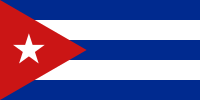Flag of Cuba
| Flag of Cuba | |
|---|---|
 |
|
| Vexillological symbol : |
|
| Aspect ratio: | 1: 2 |
| Officially accepted: | May 20, 1902 |
The flag of Cuba was officially adopted on May 20, 1902. This has been the state flag of Cuba since independence from Spain.
description
The flag consists of five horizontal stripes of equal size in blue and white. On the left side, the stripes are covered by a red, equilateral triangle. It depicts a white, five-pointed star located in an imaginary circle, the center of which lies on the geometric center of gravity of the triangle.
history
1823: The flag of the Soles y Rayos de Bolívar
In 1823, the Masonic lodge Suns and Rays Bolivars (Soles y Rayos de Bolívar) tried, together with other secret societies based on the model of Simón Bolívar, an uprising in Cuba, through which the Spanish colonial rule should be eliminated and the República de Cubanacán founded. This flag showed a sun on a blue background, which is surrounded by a red frame.
1850: The Narciso López flag
In 1850, the annexationist Narciso López brought a flag to Cuba that was modeled on the American flag . The first copy was sewn by Emilia Teurbe Toton . Her husband Miguel created the national coat of arms of Cuba . Narciso López had the plan to liberate Cuba from Spanish colonial rule and to integrate it into the USA . He landed in Cuba with an invasion force in 1850, but failed in the attempt to drive out the Spaniards and was executed as a traitor in Havana .
1868: The flag of Carlos Manuel de Céspedes
When Carlos Manuel de Céspedes released the slaves on his estate La Demajagua in 1868 and called with the Grito de Yara to fight against Spanish colonial rule, the flag he used differed significantly from that of Narciso López. The intention of Céspedes was to create a Cuban state that would not depend on either Spain or the USA.
In the following Cuban independence struggle between 1868 and 1898 , he was unable to prevail against the large landowners of the Cuban West who were convinced of the idea of annexation to the United States and who owned the sugar barons and slaves, which is also reflected in the choice of the national flag . The flag of Narciso López prevailed against that of Carlos Manuel de Céspedes as the current national flag of Cuba. After all, the Céspedes flag is the jack of the Cuba Navy today .
Cuba's flag as a model
The flag of Puerto Rico is similar to the Cuban flag because the Puerto Rican independence movement against the Spanish colonial power was based on the Cuban War of Independence. Only the colors blue and red are swapped. The flag of Narcisco López and the flag of Puerto Rico also inspired the Catalan Estelada from 1918/19 (or older?), The symbol of the Catalan independence movement and pancatalanismo .
Web links
- Símbolos de la nación cubana - Acerca de la bandera (Spanish)
- Flags of the World - Cuba (English)


